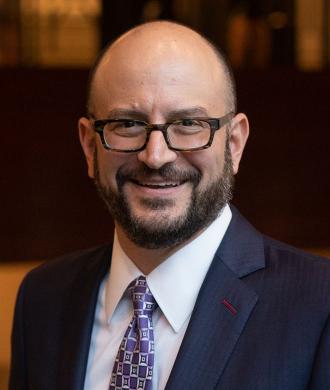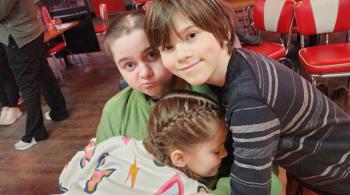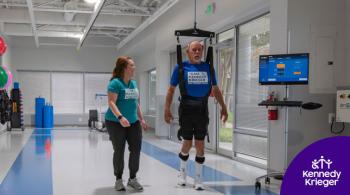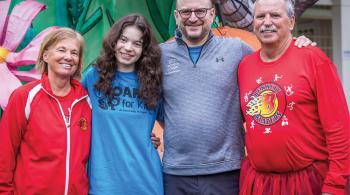Muscular Dystrophy
In this episode of Your Child’s Brain, Dr. Brad Schlaggar is joined by his Kennedy Krieger colleague, Dr. Doris Leung, to discuss a set of diseases of muscle that we refer to collectively as muscular dystrophy (MD). Muscular dystrophy is actually a group of rare genetic diseases that cause progressive weakness and degeneration of muscles. Overall, the muscular dystrophies vary in age of onset, severity, and the pattern of the affected muscles. A general principle shared by all forms of MD is that they grow worse over time as muscles progressively degenerate, atrophy, and weaken.
For more information about muscular dystrophy, these resources might be helpful:
- Kennedy Krieger Center for Genetic Muscle Disorders
- Parent Project Muscular Dystrophy
- Myotonic Dystrophy Foundation
- FSHD Society
Learn More About Our Featured Speakers
Learn More About Our Featured Speakers
View Episode Transcription
Dr. Bradley Schlaggar (BS): Welcome to Your Child's brain, a podcast series produced by Kennedy Krieger Institute with assistance from WYPR. I'm Dr. Bradley Schlaggar, President and CEO of Kennedy Krieger Institute. When we talk about our nervous system, in general, we're referring to the brain, brain stem, spinal cord, nerves, and also muscles. You have three types of muscle, skeletal muscle involved in voluntary movements, cardiac muscle, so hearts can pump blood, and smooth muscle, which is involved in the function of our intestines, arteries, and other organs. In this episode of Your Child's Brain, we'll be talking about a set of diseases of muscle that we refer to collectively as muscular dystrophy. Muscular dystrophy is actually a group of rare genetic diseases that cause progressive weakness, and degeneration of muscles, predominantly skeletal muscles, but the other muscles can be involved as well. Overall, the muscular dystrophies of which there are more than 30 and which affect about one and 4,000 people vary in their age of onset, severity and the pattern of the affected muscles. General principle shared by all forms of muscular dystrophy is that they grow worse over time as muscles progressively degenerate, atrophy, and weaken. Muscular dystrophy can involve other tissues besides muscle. That's because muscles, both skeletal and non skeletal have so many important contributions to other organs in our bodies, and because some rare neurogenetic diseases directly disrupt the development and functioning of other organs, including the brain. Regular listeners to this podcast know that we've talked often about the challenges posed by rare diseases, that while any given rare disease is rare, collectively, rare diseases are common with approximately 7,000 described rare diseases affecting 25-30 million US adults with a disproportionate number of those diseases involving the nervous system. To help us dive deeper into muscular dystrophies we're joined by my exceptional colleague from Kennedy Krieger Institute, Dr. Doris Leung. Dr. Leung, a neurologist, is the director of the Center for Genetic Muscle disorders at Kennedy Krieger, and is an associate professor in the Department of Neurology at the Johns Hopkins University School of Medicine. Welcome Doris. Let's start our discussion with some basics. Can you explain what we mean broadly by genetic muscle disorders?
Dr. Doris Leung (DL): The genetic muscle disorders are a class of diseases that primarily affect skeletal muscle, which are the muscles that are in your arms and your legs that allow you to move. There are many different types of muscle diseases. But the type that I specialize in are genetic. They are potentially inherited diseases, usually that are caused by defects in the DNA of different proteins that are used by muscle.
BS: Broadly speaking, what are the symptoms that you see with patients with muscular muscular dystrophy?
DL: By far, the most prevalent symptom is muscle weakness. I think that we all have an understanding of what muscle does, but I think it's unique really among all of the other cell types in that its function is to actually change size. All of your cells have a nucleus and have the same basic structure. But muscle cells have sub specialized in a way that they line up end to end and form these very, very long fibers, and they shrink as like a spring coiling up together. Then they can also relax and lengthen and allow and allows you to move. It allows every part of you to move. It allows you to generate force. When the muscle is no longer functioning, it doesn't do those things. It doesn't generate force, and you don't move and that's what we call weakness. There can be any number of other symptoms that go along with this, but in the primary diseases of muscle, by far and away, this is the most common symptom.
BS: You mentioned before that your particular area of focus happens to be the genetic disorders of muscle. Are all of these disorders genetic? If not, what are some of the other causes that can lead to what looks like a muscular dystrophy?
DL: All of the diseases that I study are genetic. But there are what we call acquired muscle diseases as well. These are diseases that are not based in the DNA. You are not born with them, but you acquire them. The largest class of acquired muscle diseases will be myositis, which are autoimmune diseases of muscle. These diseases also cause muscle weakness. But for different reasons, in the case of myositis, it's your own immune system starts to attack the muscle, and we'll just start breaking it apart. Most of the genetic muscle diseases, what is happening is that there's some key protein that is included in the muscle one of the bricks in the wall. There's a defect there that it doesn't function normally. Over time, this causes muscle to break down or become unstable. Your muscle can repair itself from its stem cells. The muscle stem cells are called satellite cells, and they will regrow new muscle from their stem cells. Over a lifetime, though there is only a certain number of cycles that you get before the cycle of degeneration and regeneration causes the muscle to basically become replaced with scar tissue. That results in the progressive weakness that we see in the muscular dystrophies.
BS: What are some of the common features in addition to weakness that disorders of muscle, whether the genetic or acquired have?
DL: They can involve other organ systems. It seems unusual sometimes to think about it. But I think when you're talking about your DNA specifically, you have to remember that your body uses the same pieces of code over and over and over again. Instead of reinventing the wheel. It's like if you have a bake sale, and you need to come up with six different pies, you don't need to invent a new crust for every pie. You just use the same pie crust recipe, and then you just and you swap out the fillings. Your body does the same thing with DNA for if you need a trans membrane section of an ion channel. Then you can just borrow one from another cell type and use that exact same code, and then change it up a little bit to suit muscle. What we find is that a lot of these genes have overlap in other organ systems. The big one, of course, would be the heart. I think that that's not too surprising to most people because the heart is also a muscle. Cardiac muscle has different structural features from skeletal muscle. But by and large, the proteins that are being used are pretty much the same. There are other types of muscular dystrophy, which were so intuitive there can be features like early cataracts. There can be abnormalities in brain function and cognition.
BS: Let's talk about that last bit a bit more. Though involvement of the brain. In what ways can you have a disorder of muscle that also directly affects brain function?
DL: One of the most common types of muscular dystrophy that I see is Duchenne muscular dystrophy. Duchenne muscular dystrophy is caused by pathogenic variants or mutations in a gene called dystrophin. Dystrophin is an enormous gene. The full length of the dystrophin is the part that has a structural function in muscle. It's the beams and the posts that hold up your house, that hold up your roof, and it provides a lot of structural support. However, there are you don't have to use the entire gene. Like I said, you don't need to use the entire pie recipe. You can just steal the pie crust part of it. There are other forms of dystrophin that are just replicating little parts of the gene. These forms of dystrophin are found in brain and other tissues. It is not completely understood what dystrophin is doing in the brain. When we start to study this population that they do have what we call these central nervous system manifestations. There is a higher risk of autism spectrum disorder, attention deficit disorder. When we start to do this more formal neuropsychological testing, one of the domains that over and over again has been implicated is verbal memory. We're really just at the beginning of finding ways to characterize the brain involvement in muscular dystrophy.
BS: So you mentioned the central nervous system just for the level set. That's the brain, the brain stem, the spinal cord, whereas the peripheral nervous system would be nerve, muscle, and then the junction between nerve and muscle. This dystrophy, which is disrupted in Duchenne, that we know it to be involved in muscle, but it's also pieces of it are involved in brain function. Both the central and the peripheral nervous system involved in this genetic disorder of muscle. It's a really important point. We're learning more. We've known for some time, patients with Duchenne muscular dystrophy have some cognitive developmental issues. We're learning more all the time about how that works. We brought Duchenne. Let's talk a bit more about it. How common is it? One of its features is that it primarily involves boys. Why is that the case?
DL: Duchenne muscular dystrophy affects, say, one in approximately 5,000 male births. The reason why it affects males more than females is because the dystrophin gene is located on the X chromosome. Females have two copies of the X chromosome. Males only have one. If there is a defect on one copy of the X chromosome, women have a spare copy as long as that version is intact, they will make their dystrophin off of the good copy and not use the bad copy. Males, unfortunately only have the bad copy, and they manifest the disease.
BS: Are there genetic disorders of muscle that mostly affect girls, or do most affect boys and girls in equal numbers?
DL: Other than there are a couple of X-linked ones, and Duchenne and Becker are by far the most common X-linked ones. The other muscular dystrophies are, for the most part, equally inherited between boys and girls. Both they're dominant or recessive diseases. There is a difference between whether they need one abnormal copy or two abnormal copies of the gene. It's inherited equally between boys and girls.
BS: Is newborn screening available at this point for muscular dystrophy?
DL: I'm going to say almost for years, there have been proponents of adding Duchenne muscular dystrophy to the newborn screening panel. I think that what has held it back is that there was no immediately available treatment. The idea of the newborn screening panel is that by identifying and treating a disease in the newborn period, that you would prevent disease from progressing or that you would be able to modify the disease in some way. Up until fairly recently, that's not really been the case with Duchenne muscular dystrophy. There are people who would say that that's not exactly the case now. There are treatments that we provide for children who are very young, but treatment in the newborn phase is still not standard.
BS: When there is evidence of a genetic muscle disorder that's in a family, what's your approach to advising a young family still thinking of having children about the role of genetic testing?
DL: We discussed this a lot. I don't think that there is one right answer. I think that we give them the information that they need, and they make their own choices based off of that. I see a lot of patients with all different types of muscular dystrophy. One of the things that we do when we diagnose someone with a new genetic disease is to take a detailed family history to see who else may be a carrier. Who else may have the disease? We do offer them testing. I think some people would be surprised at how often it gets turned down. I think this is a really personal choice. There are definitely people who will say, yes, I absolutely want to know. I'll get the entire family tested so that we know.
BS: You mentioned that a big part of your practice is adults, I said at the front end that you're a neurologist, actually, you're not trained especially in pediatric neurology, though you have seen many patients with pediatric-onset muscle disease.
DL: Yes.
BS: You see patients across the lifespan, really including adults. What are some of the kinds of muscular dystrophy that begin in adulthood?
DL: One of the most common ones that I see is called facioscapulohumeral muscular dystrophy. This one is almost always diagnosed in adulthood. It could be that there is just part of it is because there can be quite a long delay before having symptom onset and arriving at a diagnosis.
BS: Doris, facioscapulohumeral, maybe you want to unpack that a bit. Where does that name come from?
DL: Before we could even do genetic testing. It hasn't really been that long since genetic testing has even been available. Really, all the neurologists had to go on was what symptoms people had and what the distribution of the weakness was. What's interesting about muscle diseases is that even though we know that the genetic defect is in every cell, it is almost never the case that every muscle is equally affected. There are always some that are going to be weaker, and some of that are stronger and some that are affected earlier, and some that can be spared until very late in the disease, which is how facioscapulohumeral muscular dystrophy came to be recognized because you would develop weakness in the face in the shoulder girdle, which is like the scapula, and also in the muscles of the humerus, which are your biceps and triceps. There are other muscles that can get involved. But this is an unusual enough combination that people recognize that it was its own separate muscle disease entity. Depending on who you're asking, it's going to be either the second or third most common muscular dystrophy.
BS: A moment ago, you mentioned that it's only been really a relatively short amount of time that we have been able to use genetic testing to confirm or disconfirm a specific genetic cause of muscular dystrophy. Historically, we used muscle biopsy and how patients showed up clinically. Let's talk about day-to-day now in your clinic. How are you making these diagnoses of muscular dystrophy?
DL: Overwhelmingly, the genetic testing has become our primary diagnostic modality. I think where it starts though, is that somebody has to recognize that this is a muscle disease. This can be that there is a loss of motor milestones or that there's increasing difficulty walking, or more frequent falling. What usually happens next is that somebody tests the muscle enzyme levels. The most common one is called the creatine kinase, so the creatine phosphokinase. It's a protein. It's very abundant in muscle.
BS: Is a simple blood test?
DL: That's a very simple blood test. When you see that it's elevated, that very frequently signifies that there is a muscle disease. It used to be at that point is where people went down the muscle biopsy route. The reason why we don't do that as much anymore is that within the muscular dystrophies, they can look very similar under the microscope. You see this combination of muscle destruction, regeneration, scar tissue. It's not a great modality for distinguishing one muscular dystrophy from another. There are a few where you can do the special stains and things like that, but nowhere close to these large genetic testing panels that we can now do. You don't have to do a muscle biopsy, which is not unsafe, but at the same time still invasive test. Now we can test a panel of over 200 genes that cause muscular dystrophy based on a saliva sample.
BS: Well, just to make sure that's clear, so there's over 30 types of diseases, but over 200 types of genes. That's because lots of different genes might be causative of the same overall genetic muscle disorder.
DL: I think that when we talk about the 30 types, we're talking about specifically the muscular dystrophies. Muscular dystrophies are a subgroup of the genetic muscle diseases. There's hundreds of genetic muscle diseases. But specifically the muscular dystrophies are, what we see with them is that you are not necessarily affected when you're born, but at some point you start to develop weakness and that weakness will progress for the rest of your life. That's where the 30 comes from. The ones that are very common are Duchenne and Becker, FSHD, which is fetoscope humeral muscular dystrophy, myotonic dystrophy. Then the limb girdle muscular dystrophies will make up all of the rest. When I first came to the Kennedy Krieger Institute, we used to name the recessive ones 2A, 2B, 2C. Then the dominant ones were 1A, 1B,1C. When I started in 2010, we had named the recessive ones up to about 2M. By eight years later, we had gone all the way to Z and so it had run out of letters. Everybody said, ''Well, now, what are we going to do?'' We basically just flipped it. Now we have the limb girdles, R1, R2, R3, R4, because we are identifying new genes that cause muscular dystrophy. This is a really very dynamic field diagnostically.
BS: Let's move to talk about how these diseases of muscle are treated. Where are we right now with treatment options for muscular dystrophies?
DL: Unfortunately, there is no cure for muscular dystrophy. There is no cure for any known muscular dystrophy. By cure, I mean that this is an intervention that will make it so that you do not have muscular dystrophy anymore, and that does not exist so far. That being said, there is a lot that goes into the management of these disorders. The differences between good management and not good management makes a huge difference in life expectancy and also quality of life. This is the focus of our multidisciplinary clinic, where we have neurologists like myself. We have pediatric, neuromuscular neurologists. We have cardiologists, pulmonologists, endocrinologists, physical therapy, occupational therapy, genetic counseling, and palliative care consultants who are all working together to provide the multidisciplinary care that these patients need. If you're keeping up with the news, you will also find that there actually have been drugs that have been approved for the treatment of some muscular dystrophies. These are not curative. These drugs are intended to slow the progression of the muscle weakness.
BS: Talk about the overall prognosis of muscular dystrophy. Where are we in that respect?
DL: The answer to this question varies quite a lot, depending on what muscular dystrophy you're talking about. If you're talking about, let's say FSHD, they have a normal life expectancy. However, about a quarter of patients will lose the ability to ambulate independently and will use a wheelchair to ambulate over the course of their life. On the other hand, the other type of muscular dystrophy we've been talking about Duchenne muscular dystrophy. Its prognosis is actually constantly changing. We were talking about Duchenne muscular dystrophy in the '80s and the '90s. The median life expectancy of a patient was 19-years-old and now it's almost 30. This has been entirely the work of not any curative intervention, but better management and the use of steroids. That's one big element of it. But then also the management of their respiratory illness and being able to support the respiratory weakness with interventions like bypass. We talk about other milestones like loss of ambulation. That usually occurs at an average age of around 12 or so, but now I think it's actually much more spread out than it used to be. If you look at some of these time to event curves that are being generated in these natural history studies, steroid treated boys with Duchenne 40% of them will still be walking at the age of 16. This is something that is changing all the time.
BS: This next question, this is really the last substantive question, and I think it's the most enjoyable one because it's about research directions and the areas of research that you think are most exciting and compelling in the muscular dystrophy world. What do you think the field is doing and what are you most excited about?
DL: The one thing that I think has really changed a lot, from the time I started studying muscular dystrophy exclusively, is actually the diversity of different trials that we're able to do. For a lot of different reasons, Duchenne muscular dystrophy was really the farthest ahead in terms of mobilizing the disease population, finding interested investors in research, and putting together their natural history studies and pushing trials forward. When I first started here, all of our trials were basically in Duchenne muscular dystrophy. As we're sitting here now, we have two that are in FSHD, two that are in limb girdle. In the next couple of years, there will be I think four different trials in myotonic dystrophy coming into the patient enrollment phase. I think that there is a lot more interest in studying these even rarer forms of muscular dystrophy, which I think is incredibly exciting.
BS: What are some good online resources where listeners can go to learn more about muscular dystrophy?
DL: I really think that a number of our patient advocacy groups have really put together some excellent material. I actually go and look at their worksheets and look at their references myself, fairly frequently. Parent project muscular dystrophy is probably the largest group that is dedicated primarily to Duchenne and Becker, Myotonic Dystrophy Foundation. The FSHD Society, all have very active, very well curated web pages. They've recruited a lot of experts to develop accessible and user friendly materials that are useful for physicians as well.
BS: Great. We'll post those resources on the web page that goes along with this podcast episode, and that's an excellent place to end. Thank you to our guest, Dr. Doris Leung. I hope that you our listeners have found this discussion about muscular dystrophies, interesting and informative. Please check out our entire library of topics on your child's brain at wyyp.org, KennedyKrieger.org/ycb or wherever you get your podcasts. You've been listening to Your Child's Brain. Your Child's Brain is produced by Kennedy Krieger Institute with assistance from WYPR, and producer Spencer Bryant. Please join us next time as we examine the mysteries of your child's Brain.

















